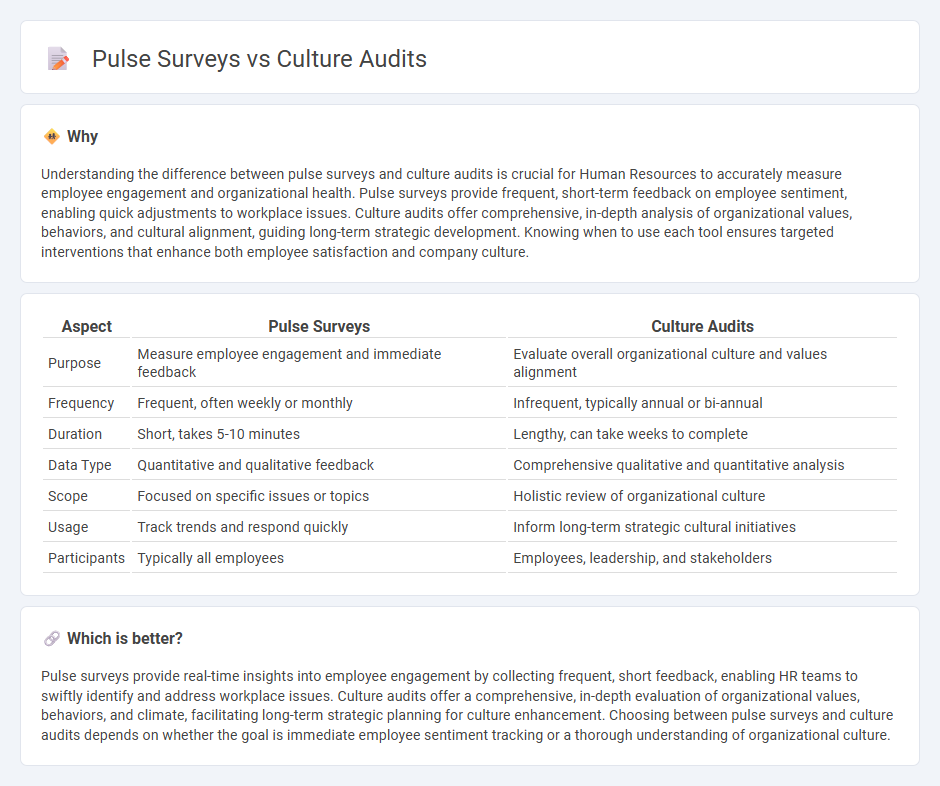
Pulse surveys offer real-time insights into employee engagement and workplace sentiment through frequent, concise questionnaires, enabling swift identification of emerging issues. Culture audits provide a comprehensive evaluation of organizational values, behaviors, and practices, delivering in-depth analysis that supports long-term culture development. Explore how combining pulse surveys and culture audits can optimize your human resources strategy.
Why it is important
Understanding the difference between pulse surveys and culture audits is crucial for Human Resources to accurately measure employee engagement and organizational health. Pulse surveys provide frequent, short-term feedback on employee sentiment, enabling quick adjustments to workplace issues. Culture audits offer comprehensive, in-depth analysis of organizational values, behaviors, and cultural alignment, guiding long-term strategic development. Knowing when to use each tool ensures targeted interventions that enhance both employee satisfaction and company culture.
Comparison Table
| Aspect | Pulse Surveys | Culture Audits |
|---|---|---|
| Purpose | Measure employee engagement and immediate feedback | Evaluate overall organizational culture and values alignment |
| Frequency | Frequent, often weekly or monthly | Infrequent, typically annual or bi-annual |
| Duration | Short, takes 5-10 minutes | Lengthy, can take weeks to complete |
| Data Type | Quantitative and qualitative feedback | Comprehensive qualitative and quantitative analysis |
| Scope | Focused on specific issues or topics | Holistic review of organizational culture |
| Usage | Track trends and respond quickly | Inform long-term strategic cultural initiatives |
| Participants | Typically all employees | Employees, leadership, and stakeholders |
Which is better?
Pulse surveys provide real-time insights into employee engagement by collecting frequent, short feedback, enabling HR teams to swiftly identify and address workplace issues. Culture audits offer a comprehensive, in-depth evaluation of organizational values, behaviors, and climate, facilitating long-term strategic planning for culture enhancement. Choosing between pulse surveys and culture audits depends on whether the goal is immediate employee sentiment tracking or a thorough understanding of organizational culture.
Connection
Pulse surveys provide real-time feedback on employee engagement and workplace sentiment, offering quantitative data essential for culture audits. Culture audits analyze these insights alongside organizational values and behaviors to identify alignment gaps and areas for improvement. Integrating pulse survey results into culture audits enables Human Resources to develop targeted strategies for enhancing employee satisfaction and organizational effectiveness.
Key Terms
Culture Audits:
Culture audits provide a comprehensive analysis of an organization's values, beliefs, behaviors, and work environment, identifying alignment or gaps with business goals and employee experience. These in-depth assessments utilize qualitative and quantitative data to diagnose cultural strengths and weaknesses, often involving interviews, focus groups, and detailed surveys with leadership and staff. Explore deeper insights on how culture audits can transform workplace dynamics and drive strategic change.
Organizational Values
Culture audits provide a comprehensive assessment of organizational values by examining long-term alignment, employee behaviors, and leadership practices, while pulse surveys offer real-time feedback on current sentiment and engagement related to those values. Culture audits reveal deep insights into how values shape decision-making and workplace norms, whereas pulse surveys capture immediate reactions and trends that may indicate shifts in cultural alignment. Explore more about integrating culture audits and pulse surveys to enhance your organization's value-driven success.
Workplace Norms
Culture audits provide comprehensive insights into established workplace norms by evaluating employee behaviors, values, and organizational rituals over time. Pulse surveys, in contrast, offer real-time snapshots of employee sentiments and attitudes towards current workplace practices and norms. Explore how these tools complement each other to foster a thriving organizational culture.
 dowidth.com
dowidth.com